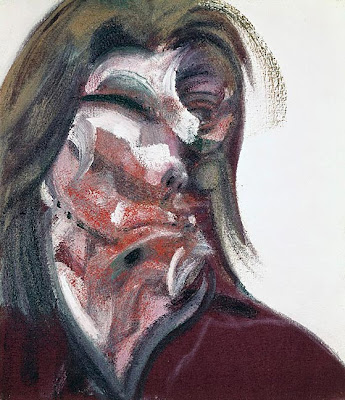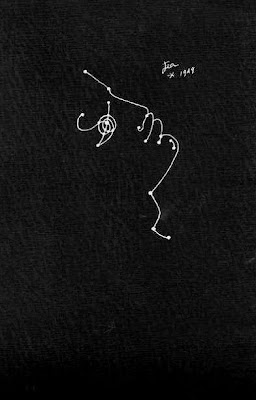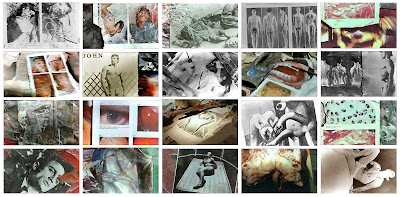"One of the nicest things Cocteau said: Each day in the mirror I watch death at work" —Bacon, quoting Cocteau in 1975.
Context. Bacon, interview by David Sylvester, March-April 1975: "I like painting good-looking people because I like good bone structure. I loathe my own face, I go on painting it only because I haven't got any other people to do. It's true to say... One of the nicest things that Cocteau said was: 'Each day in the mirror I watch death at work.'"
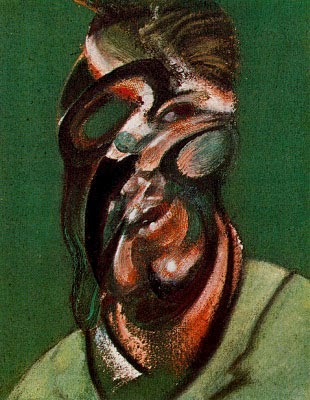 Francis Bacon, Self-Portrait, 1964. Exh. Marlborough Fine Art, London, March-April 1967
Francis Bacon, Self-Portrait, 1964. Exh. Marlborough Fine Art, London, March-April 1967
The words quoted by Bacon are from Jean Cocteau's tragedy
Orpheus of 1925: «
Chaque jour dans le miroir, je regarde la mort au travail ».
_____
Jean Cocteau, Orphée, 1925 (André Durand,
Jean Cocteau,
Comptoir littéraire, document 4, pp. 16-17; 27.2.2012)
Orphée (1925), tragédie en un acte et un intervalle. L'action se déroule dans la maison du poète Orphée et de sa femme, Eurydice, dans une Thrace de fantaisie. Orphée a ramené chez lui un cheval mystérieux, un cheval frappeur, et, envoûté, il écoute les messages de l'au-delà qu’il lui transmet ; il lui a dicté une phrase incompréhensible : «Madame Eurydice reviendra des Enfers» (ou « M... E... R... D... E... »). Son épouse, Eurydice, lui reproche de trop s'occuper de poésie et pas assez d'elle. Aussi, en l'absence d'Orphée, se propose-t-elle de tuer le cheval avec l'aide d'un curieux vitrier qui s'élève parfois dans les airs : l’ange Heurtebise qui veille sur le couple. Aglaonice, reine des bacchantes, lui a justement remis du poison sous la forme d'un sucre et d'une enveloppe qu'Eurydice lèche à son insu : elle meurt. De retour chez lui, Orphée constate que sa femme a disparu. Pour la retrouver, il doit traverser un miroir et descendre au royaume des morts. Aidé par l’ange, il en revient avec Eurydice, qu'il ne doit pas regarder. Mais, au cours d'une dispute, il oublie sa promesse, et elle disparaÎt à tout jamais.
Cependant, Aglaonice et les bacchantes se déchaînent contre lui, le démembrent et le décapitent. Il va donc rejoindre Eurydice.
La police arrive, mène son enquête avec pour interlocuteurs la tête d'Orphée et l’ange Heurtebise qu’elle arrête parce qu’il ne satisfait pas son besoin de rationalité. Mais il disparaît et va rejoindre dans l'autre monde le couple heureux, désormais inséparable. Dans la dernière scène, alors que le décor disparaît, Orphée et Eurydice rentrent par la glace. Ils sont conduits par Heurtebise : le vitrier volant était leur ange gardien.
Commentaire. Avec "Orphée", nous pénétrons de plain-pied dans le mystère ; la pièce se déroule dans un univers au-delà du réel, qui nous dévoile des vérités profondes, touchant l'essence même de la poésie et de tout ce qui dépasse notre entendement. Le poète, au cours du drame, médite sur la mort et l'au-delà pour lequel le Temps n'existe pas, puisqu'il est une invention des êtres humains. L'esprit de poésie habite Orphée, il en est l'aura. D'ailleurs, la pièce entière n'est que le drame de la poésie et de ceux qu'elle possède.
Fasciné par la tragédie et les mythes dans ce qu'ils ont d'intemporel et de moderne, Cocteau a repris ce sujet antique, mais en universalisant la tragédie par le recours délibéré à l’insolite et à l’anachronisme. Si elle suit les grandes lignes de la légende, cette «tragédie en un acte et un intervalle» n'en est pas moins un modèle d'irrespect à l'égard du chantre de Thrace. La fantaisie de Cocteau s'exerce sous la forme parodique chère aux surréalistes. Multipliant les effets scéniques invraisemblables, accumulant les anachronismes, le poète démythifie aussi les conventions du théâtre bourgeois, réaliste et sérieux. L'univers de sa pièce est celui du surnaturel : si Eurydice est en quête de simplicité, Orphée, lui, n'hésite pas à «traquer l'inconnu», dût-il se couvrir de ridicule.
Les personnages de la fable antique sont en effet traités sur le mode dérisoire des préoccupations quotidiennes, et n'échappent pas à la trivialité. Orphée se rend-il seulement compte que l'acrostiche que lui souffle le ciel, «Madame Eurydice Reviendra Des Enfers», forme le mot de Cambronne? Mais ils rencontrent aussi une autre mythologie, non moins dérisoire, celle du monde moderne, avec ses gadgets, sa technicité de pacotille, ses clichés culturels tels que Roland Barthes les recensera, justement, dans "Mythologies". Ainsi la mort communique ses ordres avec une «machine électrique» ; les bacchantes deviennent l'allégorie du public malveillant, des cabales qui déchirent l'artiste ; le sacrifice du poète lui-même semble nécessaire à la survie de son oeuvre. Le symbole de la tête statufiée souligne ce paradoxe : pour accéder à l'éternité, il faut savoir donner sa vie en pâture aux critiques.
À cet inventaire de situations tragiques mais toujours irréelles sinon ubuesques, il convient d'ajouter les hantises personnelles de Cocteau, la présence énigmatique du vitrier, l'obsession des miroirs («Les miroirs sont les portes par lesquelles la Mort va et vient. [...] Du reste, regardez-vous toute votre vie dans une glace, et vous verrez la Mort travailler comme des abeilles dans une ruche de verre.» - «Chaque jour dans le miroir je regarde la mort au travail»), l'identification quasi complète enfin aux différentes étapes de la légende. Cocteau s'est suffisamment expliqué dans son journal sur la métaphore du vitrier dont la hotte figure les ailes de l'ange, et sur le glissement de Gabriel à Heurtebise. La genèse d'"Orphée" est éclairante. On peut y voir une fable biblique se métamorphoser en drame du néopaganisme pour donner naissance à une mise en scène à peine déguisée de l'inspiration poétique : «Ma pièce devait être primitivement une histoire de la Vierge et de Joseph, des ragots qu'ils subirent à cause de l'ange (aide-charpentier), de la malveillance de Nazareth en face d'une grossesse inexplicable, de l'obligation où cette malveillance d'un village mit le couple de prendre la fuite. L'intrigue se prêtait à de telles méprises que j'y renonçai. Je lui substituai le thème orphique où la naissance inexplicable des poèmes remplacerait celle de l'Enfant divin.»
Un tel éclectisme est caractéristique de la modernité de Cocteau, parfois considéré, du fait même de ses outrances, de sa désinvolture à l'égard des valeurs établies, comme un mystificateur. Non conformiste, de l'aveu même de l'auteur, la pièce s'inscrit néanmoins dans le courant de désacralisation des mythes qui alla en s'amplifiant aussi bien dans le théâtre de Giraudoux (voir "Électre") que chez Anouilh ("Antigone") ou Sartre ("Les mouches"). La profanation, la provocation sont omniprésentes, au même titre que l'humour : la mort prend des gants (de caoutchouc !) pour négocier avec les humains. Le rôle d'Heurtebise est souligné par l'inévitable jeu de mots sur le vol, dont Eurydice évoque incidemment l'inquiétante polysémie : «Je n'aime pas les fournisseurs qui volent», dit-elle avec une méfiance toute prémonitoire ! Ainsi le destin pathétique d'Orphée est-il largement compensé par le comique de situation, le visage familier de la mort, l'intimité de la scène finale : l'orphisme y prend les allures d'un drame domestique. Sa dimension véritablement métaphysique n'apparut que dans les oeuvres destinées à l'écran, plus particulièrement dans "Le testament d'Orphée", où l'itinéraire du héros, remontant jusqu'au culte d'Osiris, emprunta la voie réservée aux initiés des religions les plus vénérables de l'humanité.
Écrite en 1925, créée par Georges et Ludmilla Pitoëff au Théâtre des Arts, en juin 1926 et publiée en 1927, cette œuvre-clé fut le premier temps d'un véritable cycle où le héros grec, après avoir incarné les affres de la création poétique, devint le fil conducteur d'un véritable rituel initiatique : le film "Le sang d'un poète" (1930), l’adaptation cinématographique de la pièce (1950), le film "Le testament d'Orphée" (1960).
____
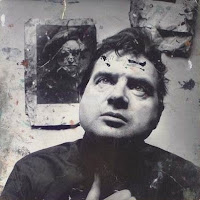 |
| Penn, Bacon, photo, 1962 |
Judith, Benhamou-Huet,
Francis Bacon par Irving Penn,
Le Point, 2.2.2006 (17.1.2007). « Je déteste mon visage, mais je le peins parce que je n'ai pas d'autre personne avec qui le faire. C'est la vérité que je dis là. Une des plus belles choses qu'ait dites Cocteau est : "Chaque jour dans le miroir je regarde la mort au travail". » C'est principalement à partir des années 60 que Bacon prend son visage comme sujet de sa peinture. Larges mandibules, face légèrement tordue, grands yeux à la mystique cachée... A la même époque, en 1962, le photographe américain Irving Penn saisit comme personne la fragilité du peintre écorché vif. Dans le fond de la photo figure une reproduction d'un autoportrait de Rembrandt, un des sujets de fascination de Bacon. Ce tirage a traîné dans l'atelier capharnaüm de l'artiste au point d'être marqué de taches de peinture avant d'être sauvé par Valerie Beston, sa femme de confiance. Avec cette histoire, l'image est devenue unique.
_____
Jean Cocteau, Orphée , film, 1949-50.
Orpheus (French: Orphée) is a 1950 French film directed by Jean Cocteau and starring Jean Marais. This film is the central part of Cocteau's Orphic Trilogy, which consists of
The Blood of a Poet (1930),
Orpheus (1949-1950) and
Testament of Orpheus (1960).
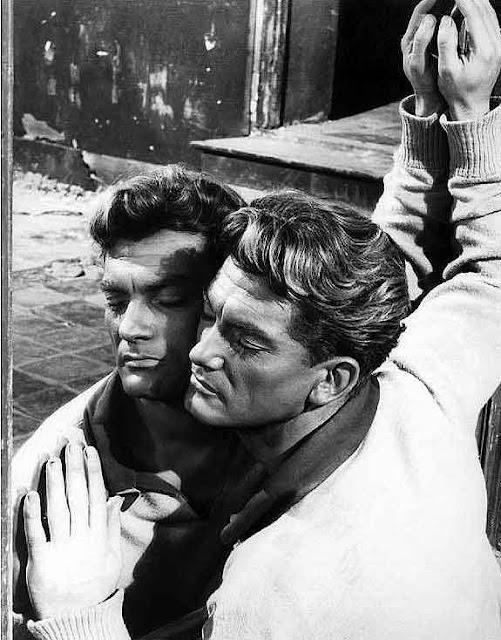 |
| Jean Marais as Orpheus in Cocteau's film |
MYTH. In the original Greek myth Orpheus was a poet whose wife Eurydice died and was taken to the underworld. Orpheus went to rescue her, to lead her back to the land of the living. He could do so only if he dared not turn to look at her while they journeyed back to life. He impulsively turned around and lost her forever.
PLOT. Set in contemporary Paris, the movie is a variation of the classic Greek myth of Orpheus. Cocteau's film updates the myth to modern, mid-twentieth-century Paris. At the Café des Poètes, a brawl is staged by acolytes of the Princess and the young poet Cègeste, a rival of Orpheus, is killed. Cègeste's body is taken to the Princess's car by her associates, and Orpheus is asked to accompany them as a witness. They drive to a chateau (the landscape through the car windows are presented in negative) accompanied by abstract poetry on the radio. This takes the form of seemingly meaningless messages, like those broadcast to the French Resistance from London during the Occupation.
Orpheus becomes obsessed with Death (the Princess). Heurtebise, her chauffeur, entertains analogous unrequited love for Orpheus's wife Eurydice. They fall in love. Eurydice is killed by the Princess's henchmen and Orpheus goes after her into the Underworld. Although they have become dangerously entangled, the Princess sends Orpheus back out of the Underworld, to carry on his life with Eurydice, but he cannot look at her or she will die. They believe it to have been a dream, Eurydice is revealed to be alive, and expecting a child.
DETAIL. At a villa, Orpheus falls asleep in front of the mirror, and wakes up on a sand dune.
EFFECTS. Throughout Orpheus, Cocteau uses very simple special effects and trick shots to show his characters passing into the world of death and back to life: They do so by stepping through mirrors, or else the film is reversed.
Cocteau adds many elements from the culture of his time. For example, the messengers of the Princess of Death are grim, leather-clad motorcyclists. The underworld is represented by buildings in France which remained in ruins after World War II, and Orpheus's trial in the underworld is presented in the manner of an inquest held by officials of the German occupation attempting to discover members of the French resistance. At the very end of the film, the Princess and Heurtebise are prisoners, brought forward to face the tribunal, ominously elevated on a pedestal above them.
Most notably, the element of the myth in which Orpheus looks back at Eurydice as she is being led out of the underworld, exactly what he was told not to do and which causes him to lose her, is represented by Orpheus happening to glance at Eurydice in the rear-view mirror of a car.
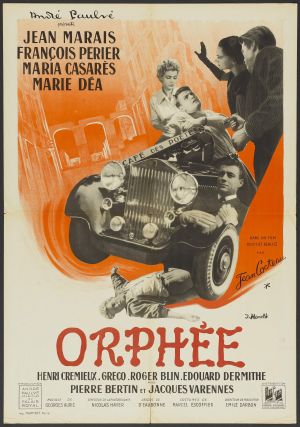 |
| Jean Cocteau, Orphée, film poster, France, 1950 |
SYNOPSIS. Orphée est un poète reconnu. Un jour, alors qu'il est au café des poètes de sa ville, il voit arriver un jeune poète saoul, accompagné d'une femme élégante. Ce dernier provoque une bagarre générale dans le café, et lors de cette altercation générale, il se fait renverser par deux motards qui prennent la fuite. La femme (qui est la Princesse) fait transporter le jeune poète dans sa voiture et ordonne à Orphée de l'accompagner. Arrivé chez la Princesse, le jeune poète est mort. Son spectre se réveille, et reconnaît la Princesse comme étant sa propre mort. Il la suit à travers un miroir, pour passer dans l'autre monde.
Orphée assiste à la scène et devient obsédé par la Mort, incarnée par le personnage de la Princesse. Il en tombe amoureux. Il se réveille dans la campagne, et le chauffeur de la Princesse, Heurtebise, le reconduit chez lui. La femme d'Orphée, Eurydice, l'attendait avec inquiétude. On apprend qu'Orphée et Eurydice sont un ménage exemplaire, et que l'amour qui les unit fait l'objet de l'admiration de leur entourage. Mais le comportement d'Orphée se modifie complètement suite à sa rencontre avec la mort.
Il passe ses journées dans la voiture d'Heurtebise, à écouter la radio : elle seule peut capter une fréquence inconnue, où sont diffusés des phrases poétiques, qu'Orphée note et reprend à son compte. C'est en réalité le spectre du jeune poète mort qui diffuse ces messages pour maintenir Orphée à l'écart de sa femme.
Eurydice, qui est enceinte, est désespérée par le comportement d'Orphée. Elle passe le plus clair de son temps avec Heurtebise. Un jour, elle reçoit la visite de la Mort d'Orphée, qui la tue par jalousie. Heurtebise tente en vain de prévenir Orphée du grand danger encouru par sa femme, mais Orphée ne l'écoute pas et reste dans la voiture à noter les phrases poétiques.
Lorsqu'il se rend compte qu'Eurydice est morte, Orphée est sous le choc. Heurtebise lui propose alors de le suivre dans l'autre monde, à travers le miroir, pour retrouver sa femme. Orphée accepte, après avoir dit qu'il souhaite retrouver sa femme, et la Mort.
Arrivé dans le monde souterrain, Orphée se retrouve au procès de la princesse : les autorités de l'autre monde lui reprochent d'avoir fait preuve d'initiative en tuant Eurydice. La mort d'Orphée reconnaît être tombée amoureuse d'Orphée. Heurtebise quant à lui, avoue être tombé amoureux d'Eurydice.
Le verdict du procès tombe : Orphée et Eurydice peuvent retourner dans le monde des vivants, mais plus jamais Orphée ne pourra pourra poser les yeux sur sa femme, sans quoi elle disparaîtra à tout jamais.
De retour dans le monde des vivants, la vie d'Orphée et d'Eurydice devient un enfer, tant il est difficile d'éviter de se regarder. Eurydice a compris qu'Orphée est tombé amoureux de sa mort, et souhaite le délivrer en le forçant à la regarder, mais elle n'y arrive pas.
C'est finalement par hasard, un jour où Eurydice vient rendre visite à Orphée dans la voiture d'Heurtebise, qu'Orphée la voit dans le rétroviseur : elle disparait instantanément. A ce moment-là, les amis du jeune poète décédé viennent attaquer la maison d'Orphée, car ils veulent savoir où a disparu leur jeune ami, après qu'on l'a vu monter en voiture avec la Princesse et Orphée. Lors de l'altercation, Orphée reçoit une balle perdue et meurt.
A nouveau dans le monde souterrain, il retrouve la Princesse, à qui il jure un amour éternel. Cette dernière décide de se sacrifier, afin de rendre Orphée immortel : Heurtebise remonte le temps avec Orphée, et change le cours des événements. Orphée et Eurydice se retrouvent dans leur chambre, et oublient ce qu'il s'est passé, s'aimant comme au premier jour.
COMMENTAIRES. Il est directement inspiré du mythe d'Orphée, transposé dans le monde contemporain, et muni d'une symbolique très riche : « Les miroirs sont les portes par lesquelles entre la mort. Regardez-vous toute votre vie dans un miroir et vous verrez la mort travailler sur vous ». « La mort d'un poète doit savoir se sacrifier pour le rendre immortel ». Dans ce film, la Mort, personnage incarné par Maria Casarès est accompagnée dans ses œuvres de deux motocyclistes, qui interviennent là où elle doit opérer. Ses ordres de mission lui sont transmis par des messages personnels du même style que ceux utilisés par Radio-Londres pendant la guerre. Si elle garde son aura et son mystère dans le monde des vivants, elle n'est plus considérée dans l'au-delà que comme un agent en service aux ordres de la bureaucratie céleste.
Jean Cocteau expliquait avoir dans ce film voulu mêler des mythes et les entrecroiser (propos repris par les Cahiers du cinéma).
Orphée, scene seven. Heurtebise, qui sert de chauffeur à la mort et de guide à Orphée: "Je vous livre le secret des secrets. Les miroirs sont les portes par lesquelles la mort vient et va. Du reste, regardez-vous toute votre vie dans un miroir, et vous verrez la mort travailler, comme des abeilles dans une ruche de verre." | English translation: "I am entrusting you with the secret of all secrets. Mirrors are the doors through which Death comes and goes. Don't tell anyone. You only have to watch yourself all your life in a mirror, and you will see Death at work like bees in a glass hive" (Jean Cocteau,
Orphée, authorized version, Duquesne University, Pittsburgh, p. 16).
EFFETS SPECIAUX. Le film est riche d'effets spéciaux :
- Séquences tournées à l'envers pour l'enfilage des gants, ainsi que pour la levée du corps de Jacques Cégeste.
- Miroirs "liquides" (en fait, des plans de mercure, d'où l'utilisation des gants, avec une caméra tournée sur le côté)
- Paysages en négatif photographique lors du passage vers la zone administrative des défunts
- Transparence lorsqu'Orphée est conduit dans cette zone par l'ange Heurtebise (lui-même hors transparence). Permettant à celui-ci de marcher immobile contre un vent violent qui n'existe pas pour Orphée, elle permet également de repasser rigoureusement la scène à l'envers (avec cette fois-ci Heurtebise de dos)
- Plan tourné à la verticale d'un plateau au sol, lorsqu'Orphée et Heurtebise retournent pour la deuxième fois dans le monde des morts
- Des miroirs qui se brisent à plusieurs reprises
- Dans quelques séquences (par exemple lorsque la princesse - la Mort - vient chercher Eurydice) où la caméra est censée se trouver face à un miroir, le spectateur peut se demander où celle-ci se cache; en fait, le miroir n'en est pas un mais une scène réelle où des acteurs jouent à l'envers de ceux face à la vraie caméra; cela se remarque au moment où la princesse pousse les battants du miroir et baisse les bras: sa doublure est plus rapide que Maria Casarès (la princesse). Lorsqu'Orphée tend les mains gantées vers le miroir, le deux mains au premier plan sont celles d'une doublure.
RECEPTION and CRITICISM
1.
The Times. "A hauntingly beautiful piece of cinema. Poet, playwright, artist and filmmaker, Jean Cocteau was one of the most significant artists of the twentieth century and Orphee his finest work of cinema.
This magical retelling of the Orpheus myth turns the lyre-playing singer of Greek legend into a famous left-bank poet in post-war Paris. Fallen out of favour and lost for poetic inspiration, Orphee becomes obsessed with a mysterious black-clad princess who first claims the life of a rival poet, and then Eurydice, his wife.
With its unforgettable imagery - the dissolving mirror through which characters pass into the next world, the leather-clad, death-dealing motorcyclists, and Cocteau's magical special effects - Orphee is a work of haunting beauty that follows the poetic logic of a dream.
Cocteau's luminous adaptation of the famous Greek myth, set in post-occupation Paris, remains one of the most stunning achievements of the auteur's career. Orphee (the iconic Jean Marais) is a successful Parisian poet, whom--despite popular acclaim--feels isolated and uninspired. When his wife Eurydice (Marie Dea) is stricken down by leather-clad bikers, he pursues them into the underworld, where he falls into a romantic entanglement with the dark-haired beauty Death (Casares). Stunning cinematography and surrealist flairs punctuate this beautiful, hypnotic masterpiece."
2.
Harvard Film Archive. "In this mesmerizing modern version of the Greek myth, Orpheus (Marais) is a modern-day poet who, like Cocteau himself, worried that his verso will not bring him immorality, and that other poets, younger and superficial ones, are scorning his talents. But abruptly, the movie slides into the through-the-mirror Underworld, like Alice dropping into the rabbit hole. It’s all mysterious and utterly magical: Orpheus’ pursuit of Eurydice (Déa) and his meetings with the Princess of Death (Cesarés). The special effects are tiny by any standard, and yet they shimmer and shiver with nightmare luminosity."
3.
Alt Film Guide. "This is a bad film in all respects. There isn't a single positive thing to say about it. Poseurs and dilettantes may love this, but there isn't an ounce of true filmic 'poetry' in the whole exercise, unlike in Fellini or Bergman. Yes, love may conquer all, and in this case Death, but need it do so in such a dull, trite, and melodramatic manner? Yes, there's the old Poetry and Death cliché, but that's what it is — and this film pathetically celebrates it instead of undermining it. It is neither low art nor high art, but faux art. Had Orpheus had a dram of real humor it may have been a brilliant parody. [...] Jean Cocteau was a bad poet, a poseur of the worst sort. [...] He mine[d] every cliché on poetry and art imaginable, besides tossing off such execrable lines as, 'You'll live to regret those words,' 'You burn like ice,' [...] and 'Who can say what's poetry or not?' as if they were profound. [...] There's no mystery in the fact that the Underworld is a stand-in for the unconscious, which is how Death communicates to the interested Orpheus most effectively, while the part about not looking at Eurydice represents the desire for artists to always forge ahead. But, so what? In
Orpheus, nothing of any depth is done with those concepts. / Is there anything that Cocteau innovates in
Orpheus? Does he even try to entertain? No, because the film is so self-indulgent and has such a precious sheen of artifice that one feels Cocteau is simply masturbating onscreen" (Dan Schneider).
Additional resource.
Jean Cocteau: Orpheus
_____
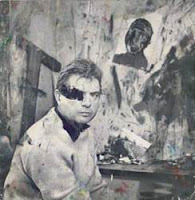 |
| Beaton, Bacon, photo, 1960 |
Cecil Beaton: A Portrait by Bacon. A most vivid account of a Bacon painting is given by Cecil Beaton, who rashly commissioned a portrait. In the finished picture, Beaton saw "an enormous coloured strip-cartoon of a completely bald, dreadfully aged —nay, senile— businessman. The face was hardly recognizable ... for it was disintegrating before your eyes ... a swollen mass of raw meat and fatty tissues. The nose spread in many directions like a polyp but sagged finally over one cheek. The mouth looked like a boil about to burst."
_____
Bacon's 1969 Self-Portrait. Here the artist exposes his inner trauma or individual conflict. In the canons of art history, the masters of self-portraiture are among the most radical and innovative of their time. Francis Bacon recognized this truism. In interviews with David Sylvester, Bacon spoke often of his admiration of Rembrandt van Rijn and the Dutch artist's long chronicle of self-portraits which he could create free of the strictures of patrons. With great acuity he observed in 1979, "I thinks the self-portaits are the greatest thing Rembrandt ever did because they were formally the most extraordinary paintings. He altered painting in a way by the method by which he dealt with himself, and perhaps he felt freer to dealt with himself in this totally liberal way" (David Sylvester,
Looking Back at Francis Bacon, New York, 2000, p. 241). Self-portraiture is best understood as a means to explore the ability of paint to represent and to convey: the artist is not studying his face simply for reasons of autobiography, but rather to probe the potentiality of pictorial representation. Along with the meticulously scrutinised faces of a handful of close friends, lovers and acquaintances, during the 1960s and the 1970s it was Bacon's own visage that became the arena for his most ferocious and original investigations into pictorial representation. Combining the sinuous paint handling, visceral intensity and psychological depth of his mature oeuvre, the eye-catching immediacy of the 1969
Self-Portrait assaults the viewer with mesmerising force.
Francis Bacon is recognized as the contemporary artist who most thoroughly explored the genre of portraiture. Throughout his career, Bacon turned to the portrait in his belief that modernist and post-war abstraction were merely aesthetic, and that art devoid of human content lacked emotional resonance. Executed at the zenith of Bacon's career when his creative ambition was freed from the obstacle of commercial success, Self-Portrait is one of the most psychollogically compelling and physically engaging works of Bacon's career, an iconic image of the artist who is himself an icon of his age.
Like Rembrandt before him, Bacon painted self-portraits throughout his life, beginning in 1956 and increasing in frecuency in the late 1960s and early 1970s. As with the shifting phases of life, the sinuous paint and vibrant color of Bacon's self-portraits conveyed everything from the existential angst and demons of the creative mind, the pain of loss following George Dyer's suicide in 1971, and the more contemplative periods of Bacon's life.
Bacon's life-long array of self-portraits is a panoply of aesthetic experimentation and revelatory panache conveying the existential and contradictory depths that are a hallmark of Bacon's oeuvre. The shifting perspectives and distorted figurations of his paintings continually manifest Bacon's internal struggle for his identity as an artist, and in the self-portraits this occurs in the most personal terms.
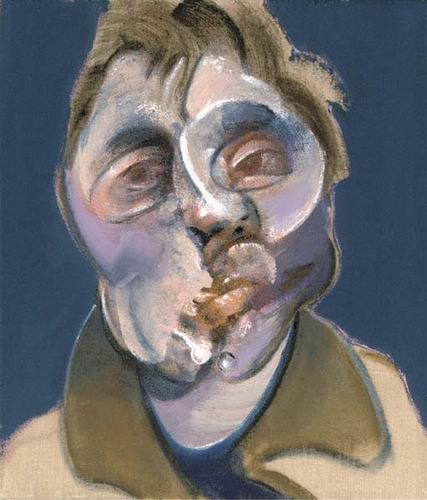 |
Bacon, Self-Portrait, 1969. Oil on canvas, 40.5 x 35.5 cm
33,081,000 USD |
Painted against a velvety dark blue background, the artist's soulful and troubled eyes in
Self-Portrait dominate the work and capture our gaze, while the swirls of textured paint deconstruct the flesh to reveal the inner structure of bone and sinew. The dematerialization of the public visage as an act of brutal analysis and truth-seeking was the crux of the challenge for Bacon to paint portraits. Like Pablo Picasso, Bacon sought to convey the principal tenets of portraiture -physiognomy, gesture and attitude, or what Bacon called "fact"- in a non-illustrative way.
Straightforward representational verisimilitude, what he termed "illustration", was as abhorrent to Bacon as it was to his modernist forebears and abstractionist peers. For him, painting had to transcend mere representation to expose something more vital and irrational: "The living quality is what you have to get. In paintig a portrait the problem is to find a technique by which you can give over all the pulsations of a person... The sitter is someone of flesh and blood and what has to be caught is their emanation" (Sylvester, p. 98). In the shifting profiles and features of Bacon's portrait heads, the distortions of the Cubist fracture are surpassed, forcing the viewer to engage in the struggle of identity along with the artist. The activated brush work and chromatic dissonance of Bacon's flesh tones compound the expressive nature of his human renderings. While Lucian Freud's portraiture is equally stunning in its voluptuous and tortured manipulation of paint as tactile flesh, one gains a stronger sense of peering "underneath the skin" with Bacon. The raw element of bone structure speaks of savage exposure nd intimate probing.
Like th other post-war 20th century icon of self-portraiture, Andy Warhol, Bacon's sense of mortality may have been more pronounced in later years, but it was ever-present as a tributary of thought. "I've done a lot of self-portraits, really because people have been dying around me like flies [...] I loathe my own face, but I go on painting it because I haven't got any other people to do [...] One of the nicest things Cocteau said: 'Each day in the mirror I watch death at work.' This is what one does himself" (Sylvester,
Interviews with Francis Bacon, 1975, p. 133).
Self-Portrait from 1969 conveys just such a haunting reverie on the human condition, as the artist's gaze is both one of introspection and expressiveness, engaging an inner dialogue while projecting an indelible aura. Source: Sotheby's e-catalogue.
_____
Kenneth Baker,
Francis Bacon's Grim Vision, Reckless Life,
San Francisco Chronicle, 17.9.1997. Ref. Michael Peppiatt,
Francis Bacon: Anatomy of an Enigma.
After Henry Moore, Francis Bacon (1909-1992) is the most celebrated British artist of the 20th century.
But whereas monumental bronzes by Moore decorate public and corporate plazas all over America, Bacon's grotesque paintings of human beings disfigured by passion or suffering still meet with critical and popular ambivalence.
Michael Peppiatt's "Francis Bacon: Anatomy of an Enigma" may spark a reassessment of Bacon's art, which is sparsely represented in American museums. [...] Peppiatt's unwavering conviction of the greatness of Bacon's work is less persuasive, though, than his portrait of the man himself.
As editor of the magazine Art International and a longtime friend of Bacon's, Peppiatt has critical credentials. His characterizations of Bacon's art are perceptive and sympathetic, but before long his rhetoric of appreciation starts to sound too well matched with the mannerism that eventually afflicted Bacon's own work.
Ironically, the most vivid account of a Bacon painting in Peppiatt's book is given by Cecil Beaton, who rashly commissioned a portrait. In the finished picture, Beaton saw "an enormous coloured strip-cartoon of a completely bald, dreadfully aged -- nay, senile -- businessman. The face was hardly recognizable ... for it was disintegrating before your eyes ... a swollen mass of raw meat and fatty tissues. The nose spread in many directions like a polyp but sagged finally over one cheek. The mouth looked like a boil about to burst."
What leaves the reader wanting a fresh look at Bacon's painting is Peppiatt's portrayal of him as a man gripped by self-destructive compulsions that he was singularly fit to withstand. Bacon's daredevil life authenticated his art's grim vision, Peppiatt argues.
Bacon's seriousness about art and life are never in doubt, although he was self-taught and almost suicidally devoted to what he called "frivolity": drinking, gambling and sadomasochistic homosexual adventure.
"Bacon revelled in living beyond the pale," Peppiatt writes. "In addition to his punishable sexuality, in which he had left no vice unturned, he had engaged in prostitution and theft of various kinds, as well as a range of other illicit practices, such as keeping a gaming house and assuming a false identity. As for drugs, Bacon would have tried most things at one time or another, out of curiosity or bravado."
Although capable of the most outrageous behavior, Bacon was strangely reticent about sharing the story of his life with critics or would-be biographers. The reason, Peppiatt believes, is that he did not want lurid personal anecdote to dilute the "enigma" or impact of his art, which he saw as something quite objective.
Yet when Peppiatt discussed with Bacon the inevitability of shocking biographical revelations, the painter said, "Well, yes of course, you must be as indiscreet as you want. ... After all that's what people are most interested in. The more indiscreet you are, the better the book will be." Peppiatt took him at his word.
The son of a tyrannical military man, Bacon spent much of his childhood on the stud farm in Ireland to which his father had retired. Bacon's father disowned him in his teens when he was caught trying on his mother's underwear. "Women's underwear and, notably, fishnet stockings, were part of the artist's wardrobe for most of his life," Peppiatt notes.
Before he was 20, the young Bacon had already lived by his wits and his looks in Berlin, Paris and London, learning how to charm and how to con. He followed his curiosity whether it led to transvestite bars or to reading Proust and Joyce.
While in Paris, he had been thunderstruck by the work of Picasso and the surrealists, but Bacon made his first career as a decorator and furniture designer. His reputation flourished briefly in London before it succumbed to his restlessness and profligate habits.
He made a run at painting, but gave it up for seven years of "drifting," after which he settled into an odd household comprised of a rich older lover, Eric Hall, and Jessie Lightfoot, his childhood nanny, who would live with Bacon until her death in 1951.
From the mid-1940s until his death, Bacon enjoyed a slow ascent to world fame and riches that enabled him to indulge his vices -- and his generosity -- to the fullest.
Bacon loved extreme states -- of intoxication, pain, pleasure, danger and concentration -- both for their own sake and because they erupted in images he could paint, images he claimed were as mysterious to him as to anyone.
Peppiatt is very good on the influences interpreters have seen in Bacon's work, from his memories of London during the world wars to the art of Velazquez, Picasso and Titian.
Peppiatt tells a wealth of stories about Bacon's life and delicately overlays the art with them, but never pretends to have the key to the man or his work. His Bacon is both extraordinary and completely believable.
_____
Bacon at the National Portrait Gallery in London
Born in Dublin, the son of a retired army officer and race-horse trainer, Francis Bacon left Ireland for Paris, Berlin and London at the age of sixteen. As Bacon himself put it, he "drifted between the gutter and the Ritz", pursuing homosexual adventures, and beginning to paint religious subjects encouraged by the Australian-born artist Roy de Maistre. He came to some early notice as an interior designer, but it was as a painter that he made an initial impact, in 1945, with his
Three Studies for Figures at the Base of a Crucifixion. A continuous stream of works followed, some taking imagery from sources as diverse as Velasquez, Van Gogh, the photography of Eadweard Muybridge, the cinema and illustrations of disease.

